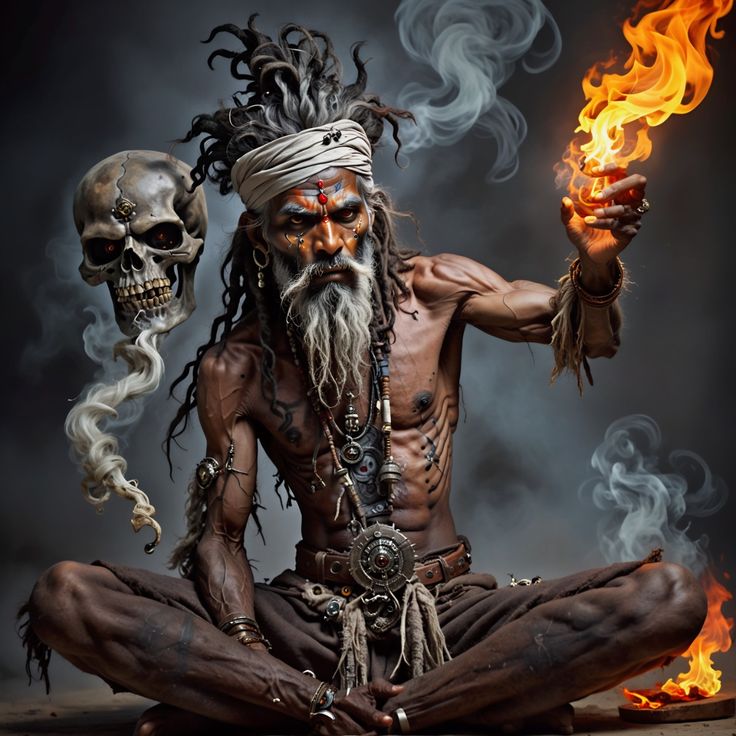Who are Aghoris? What do they actually do and why do they only come out in public during Kumbhs?
Aghoris are practitioners of a highly esoteric and controversial tradition within Hinduism, often associated with intense rituals, meditation, and ascetic practices. The term “Aghori” literally means “not fearful,” referring to their fearless approach to life, death, and the supernatural. They are most commonly linked to the worship of Lord Shiva, particularly in his form as Kailash, and his association with destruction, transformation, and the transcendence of dualities.
What Do Aghoris Do?
Aghoris are known for their unconventional and extreme practices that aim to transcend worldly attachments and discover higher states of consciousness. Their methods may seem shocking to outsiders, as they often involve practices that defy societal norms, such as:
- Rituals in Cremation Grounds: Aghoris often perform their spiritual rituals in cremation grounds or burial sites, meditating on death and decay. By engaging with death, they seek to understand its impermanence and eliminate the fear of mortality.
- Consuming Taboo Substances: In their rituals, Aghoris sometimes engage in the consumption of substances considered taboo by mainstream society, such as human flesh, alcohol, or even feces. These practices are believed to break societal taboos and transcend the concept of “purity” and “impurity.” It is important to note that these actions are deeply symbolic, representing the transcendence of the ego and worldly attachments.
- Tantric Practices: Aghoris are often practitioners of Tantra, an ancient Hindu system of spiritual techniques that uses rituals, mantras, and meditation to connect with higher powers and transcend the dualities of good and evil, life and death. They often meditate on the Shiva Lingam (symbolizing Lord Shiva) and seek union with the divine.
- Asceticism and Renunciation: Aghoris lead ascetic lifestyles, renouncing material possessions and worldly attachments in order to seek spiritual liberation. They live in isolation, often wearing minimal clothing (or none at all) to demonstrate their detachment from physical desires.
- Healing and Blessings: While their practices are controversial, some Aghoris are also known to provide spiritual healing, using their connection with the divine to remove curses, provide blessings, and offer protection to their followers.
Why Do Aghoris Appear During Kumbh Mela?
The Kumbh Mela is one of the most important and grand Hindu festivals, held at four locations in India at regular intervals (every 12 years). It is a gathering of millions of Hindus who come together to bathe in sacred rivers and cleanse their sins. The presence of Aghoris during this festival is significant for several reasons:
- Ritual Significance: The Kumbh Mela is a deeply spiritual and symbolic event, representing the cleansing of the body and soul. For Aghoris, who believe in transcending dualities and achieving spiritual liberation, the Kumbh Mela offers an opportunity to perform powerful rituals and connect with the divine in a public, collective setting. Their presence during such a grand gathering aligns with their belief in confronting the taboo and the extremes of life and death.
- Affiliation with Shiva: Many Aghoris are followers of Lord Shiva, and they view the Kumbh Mela as a sacred event that aligns with their spiritual path. The event’s association with purification and divine blessings resonates with their beliefs, and it allows them to showcase their devotion to the deity in the form of rituals and practices that are central to their tradition.
- Raising Awareness and Seeking Devotees: The Aghori community is often seen as mysterious and misunderstood. By appearing during the Kumbh Mela, they draw attention to their teachings and philosophy. Their extreme practices challenge the conventional understanding of spirituality and offer a different perspective on what it means to achieve spiritual enlightenment.
- Communing with Other Spiritual Seekers: The Kumbh Mela is not just a religious gathering; it is also a place for spiritual seekers of all traditions to unite. For Aghoris, it is an opportunity to interact with other ascetics, sadhus, and devotees. While Aghoris typically lead isolated, solitary lives, the Kumbh Mela offers a rare occasion for them to engage with others and share their wisdom.
- Symbolic Representation of the Supernatural: Aghoris are viewed as embodiments of the supernatural, as they often perform seemingly impossible feats and embody intense spiritual energy. At the Kumbh Mela, they act as living symbols of the power of Lord Shiva and serve as a reminder of the mysteries of the universe. Their appearance reinforces the idea that there is a deeper, mystical side to life beyond the physical world.
Why Do Aghoris Stay Out of Public View?
Aghoris are not typically visible in public because their practices and philosophies are far removed from mainstream Hindu society. Their rituals, which often involve death, decay, and the breaking of social norms, are seen as extreme and controversial. The primary reasons they remain largely secluded are:
- Spiritual Discipline: Aghoris live ascetic lives, focusing on inner transformation and spiritual discipline. Their practices are designed to lead them into higher states of consciousness and divine connection, which requires seclusion from worldly distractions.
- Transcendence of Society’s Norms: Aghoris believe in transcending the limitations of society, particularly the concept of purity and impurity. They reject societal norms that dictate what is sacred or profane. As a result, their practices may be misunderstood, and they prefer to avoid public scrutiny.
- Connection with the Divine: Aghoris prioritize their connection with the divine above everything else. They believe that public exposure or attachment to worldly matters could dilute their spiritual progress. Their focus is on internal growth, and their physical presence in public is only seen as necessary for fulfilling their spiritual duties or performing important rituals, such as during the Kumbh Mela.
- Mystical Aura: The Aghoris’ deliberate choice to stay out of the public eye also contributes to the mystique surrounding them. Their enigmatic nature, along with their extreme practices, has led to the perception of them as mystical and otherworldly figures, which only adds to their allure when they do appear in public, especially at significant spiritual events like the Kumbh Mela.
Conclusion
The Aghoris are a unique and often misunderstood group within Hinduism. Their radical practices, focus on transcendence, and connection with the divine through death and taboo challenge conventional spiritual perspectives. They are not merely ascetics or mystics; they embody a philosophy that seeks to go beyond the surface of life and engage with the raw, unfiltered aspects of existence. Their appearance at the Kumbh Mela, a gathering that draws millions seeking divine blessings, provides an opportunity to witness their extreme devotion and powerful spiritual presence. Through their rituals, teachings, and practices, Aghoris serve as a reminder that spiritual enlightenment can come through embracing the darkest aspects of life, ultimately leading to a deeper understanding of the nature of existence.










